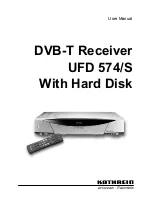
Reproduction is permitted provided copyright information is intact.
C O A X N E T W O R K I N G
“Don’t Call Me DECA”
There’s a lot of confusion about the term
“DECA.” A lot of people use the term to mean
networking using your satellite cables.This is
actually just called Coax Networking. The idea
is that all your receivers communicate with
each other through the satellite cables. This
creates a smooth, clean path for sharing HD
video and makes it easier for DIRECTV techs
to set up without disturbing the rest of your
network. So what is a DECA? It’s a device that
converts from ethernet to coax. That’s what the name means... DIRECTV Ethernet Coaxial Adapter.
DIRECTV ETHERNET
COAXIAL ADAPTER
Anytime you want to convert from coax networking to
ethernet networking, you need a DECA. DECA stands
for “DIRECTV Ethernet Coaxial Adapter.” What you see
is the Generation II DECA, but if you have the old-style
white box DECAs they will work just as well.
The following receivers will use a DECA to convert the
coax network signal to an ethernet one:
Because these receivers don’t have built-in coax networking, they need an adapter to convert the
network part and put it into the receiver’s Ethernet port. Using a DECA is easy. Connect one end to
the satellite cable and then connect BOTH the coaxial and ethernet cables to the receiver. Within a
minute or two all the lights on the DECA should turn green indicating good communication.
You may need to do the “Connect Now” procedure to get networked on these receivers.
If you accidentally use a DECA on an H24, H25, HR24, or HR34 receiver it simply won’t work. As a
rule of thumb, if it’s got a flat, touchscreen front, it doesn’t need a DECA in back.
• HR20
• HR21
• HR22
• HR23
• H21
• H23
• R22
• THR22 (TiVo)





































